Byzantine Coinage › Byzantine Empire › Etruscan Trade » Origins and History
Articles and Definitions › Contents
- Byzantine Coinage › Origins
- Byzantine Empire › Origins
- Etruscan Trade › Origins
Ancient civilizations › Historical places, and their characters
Byzantine Coinage › Origins
Definition and Origins
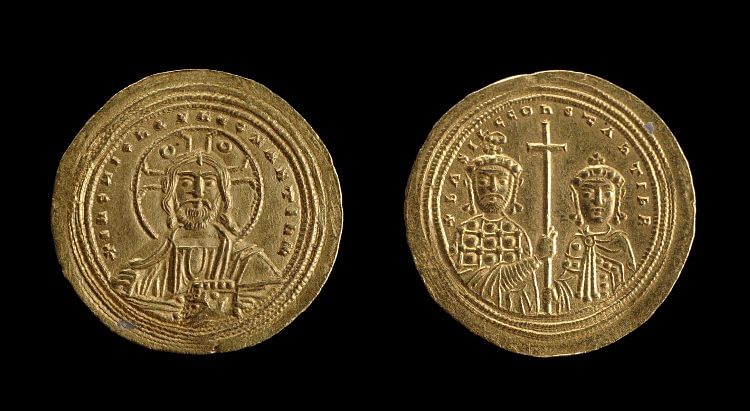
The coinage of the Byzantine Empire continued that of its more ancient predecessors and functioned as a convenient method of payment for goods and services, especially to soldiers and officials, and as a means for people to pay their taxes.Coins also continued to be the best way for a ruler to spread their image and remind their people who they owed their allegiance to. The star of the Byzantine purse was undoubtedly the gold solidus or nomisma. Introduced by Constantine I in the 4th century CE, it would reign supreme as the currency standard for 700 years, eventually to be replaced by the electrum hyperpyron from the 12th century CE.
THE NOMISMA AS STANDARD
Every Byzantine emperor minted their own coins, from either Constantinople, the capital, or in mints in major provinces such as Italy (Ravenna), Sicily ( Syracuse ), Anatolia (Antioch), and North Africa ( Carthage and Alexandria ). As in the ancient world, the value of coins in Byzantium depended on their weight and the purity of the metal used to produce them. The main coin of the Byzantine empire for 700 years was the solid gold nomisma or solidus in Latin. On its introduction in the East in 312 CE by emperor Constantine I (r. 306-337 CE), 72 nomismata were equal to one pound of gold. Thus, each example weighed 4.4 grams of pure gold and measured between 21 and 22 mm in diameter. The first versions carried a portrait of Constantine on the obverse (front) and Roman army standards on the reverse side. Further currency reforms were carried out by Anastasius I (r. 491-518 CE) whose reign actually marks the beginning of Byzantine coinage proper for numismatists.
Such was the nomisma’s longevity and reliability - Basil II was still minting them in the 1020s CE - that the worth of all other lesser-value coins made of gold, silver, or copper was measured against it. For example, the gold semissis was equal to half a nomisma, while three gold tremissis coins were worth one nomisma. Both of these coins would still be in circulation in the late 9th century CE.
ONE NOMISMA COULD HAVE BOUGHT YOU A PIG, THREE WERE NEEDED FOR A DONKEY, & FIFTEEN WAS THE PRICE OF A CAMEL.
The most common silver coin was the miliaresion, introduced in 720 CE, twelve of which were worth one nomisma. The most common copper coin was the large follis, introduced by Anastasios I (r. 491-518 CE) to improve the poor quality coins of previous emperors, which was worth very little but was useful for small transactions: 24 folles were equal to one miliaresionwhile a whopping 288 were required in exchange for a single nomisma. In terms of actual value, a labourer would have earned between five and twelve folles a day while a middle-ranking official earned some 1000 nomismata per year. One nomisma could have bought you a pig, three were needed for a donkey, fifteen was the price of a camel, and a slave with a few skills would have set you back 30 gold coins - a purchase to be made with care, clearly. Aristocrats measured their wealth in the thousands of nomismata while in the rare cases where a field army's four-year treasure chest was stolen by the enemy, such as the Bulgars in 809 CE or the Arabs in 811 CE, we know that it consisted of 80-90,000 nomismata - enough to make a tax collector's eyes water.
DEVALUATIONS
The nomisma did face brief challenges to its dominance. In the 6th and 7th century CE a less pure gold coin (22 carats as opposed to 24) was minted but did not last. A more serious challenger came in the mid-10th century CE in the form of Nikephoros II Phokas' (r. 963-969 CE) attempt to save even more gold and produce more coins. He minted a gold coin, the tetarteron, which was not only 22 carats instead of pure gold but also with one-twelfth less weight than the nomisma. In the first half of the 11th century CE, Constantine VIII (r. 1025-1028 CE) and Michael IV (r. 1034-1041 CE) both nibbled at the nomisma itself and added 5% silver to eke out more bang for their buck. This was the beginning of a slippery slope towards a much-devalued currency.
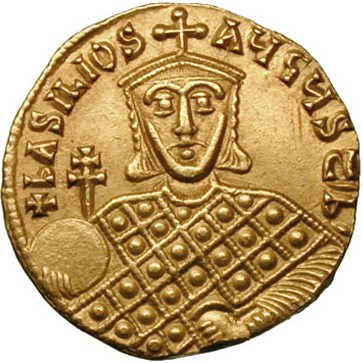
Basil I
It is debatable if emperors understood or not the long-term economic consequences of undermining their own currency, but they could not resist consistently tinkering with the gold content of their coins, reducing it when the state coffers were low and endangering confidence in the coin. Perhaps the practical necessity of the moment and the need to pay mercenary soldiers to defend the empire or make up for tax shortfalls when plagues hit the population took precedence over economic theory. As a consequence, over the whole of the 11th century CE, the gold content of the nomisma gradually went down in stages from 20 to 18 to 16 to 12 and ended up around 8 carats during the reign of Nikephoros III Votaneiates (r. 1078-1081 CE).
In the 10th century CE there were, in fact, six different versions of the nomisma in circulation and international merchants even began to favour Arab gold dinars. The state of the premier coin of the realm became so bad and prices were rising so quickly that reform was urgently needed. Consequently, Emperor Alexios I Komnenos (r. 1081-1118 CE) minted a new coin c. 1092 CE, the hyperpyron (meaning “highly refined”), which became the new standard, even if it was actually made from electrum (an alloy of gold and silver) and worth only a third of the nomisma. Alexios had sorted out the currency confusion of nobody knowing quite what the equivalents of all the coins in circulation were, but he also, rather astutely, managed to quadruple tax rates in the process. The hyperpyron did take a few decades to take off and, like the nomisma, it occasionally suffered a debasement, notably during the reign of Michael VIII (r. 1259-1282 CE), but it would survive until the fall of the empire in the 15th century CE.
IMAGERY
Coins were spread far and wide thanks to merchants and travellers so they could be used to good effect as a useful means of propaganda by rulers eager to extend their power and fame into every corner of the empire and to its neighbours. Portraits were conventionalised and did not approach the realism of, say, ancient Hellenistic or Roman coins. They usually show the person front on rather than in profile and holding a cross, sword, or sceptre. The name is helpfully written, too, which is just as well given the often poor likenesses of the time.
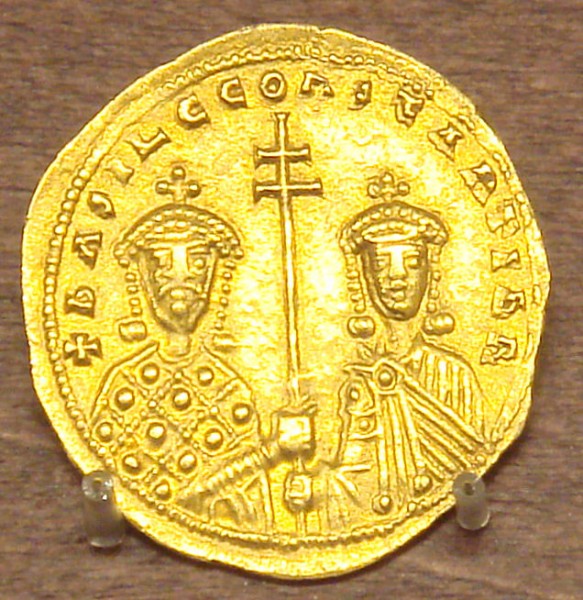
Coin of Basil II
Not only could the emperor or empress put their own face on the front of the coin - Empress Irene (r. 797-802 CE) went one better and put herself on both sides - but they could reinforce their message with other symbols of imperial power on the back.Short legends were first written in Latin, then in Latin and Greek, and then wholly in Greek from the 7th century CE.Constantine I often used the Tyche of Constantinople on the reverse of his coins. A symbol of good fortune, she sits on a throne, wears a crown with battlements and holds a cornucopia. The cross of Christianity and the Christogram became a favourite choice for many subsequent emperors. The Virgin or saints frequently appear while the coins of Alexander (r. 912-913 CE) have John the Baptist being crowned by the emperor.
JUSTINIAN II (R. 685-695 CE) WAS THE FIRST EMPEROR TO SHOW JESUS CHRIST ON COINS C. 691 CE.
Justinian II (r. 685-695 CE) had been the first emperor to show Jesus Christ on coins c. 691 CE along with the legend rexregnantium (“King of kings”). There were two versions of Jesus, one with a beard and one without, and they are similar to surviving mosaic portraits. Perhaps it is no coincidence that this pious emperor insisted that the Arab caliphate pay their tribute with these coins (which they refused and, in response to the affront, successfully invaded Anatolia to boot). By the mid-9th century CE Christ was regularly shown on the obverse of coins with the legend “Jesus Christ, King of those who rule.” The reverse sides of these coins showed the emperor being crowned by Christ, the Virgin, or a particular saint, and so reminded people that he or she was God's representative on earth.
Coin portraits were also used for political endorsements, especially when emperors had selected their chosen heir and wished to avoid a messy succession dispute after their own death. The child was often crowned as co-emperor and shown as such on coins, side by side with their parent or on the reverse side, sometimes with a sibling alongside.
CIRCULATION
For most people, the copper and silver denominations of coins would have been the only ones they handled on a daily basis.Those lucky enough to have a shiny gold nomisma in their palm probably did not keep it for very long as one of the main reasons for the state to mint coins in the first place, besides to pay soldiers and officials, was to more easily collect taxes.There were basic and ever-present taxes on land and persons/households, besides any other ingenious excuse the tax authority could come up with, such as a levy on any slave imported from a particular region. Further, all taxes had to be paid in gold coins, which was probably why the state was so vigorous in ensuring their quality.
In fact, the minting of nomisma coins was so carefully monitored and their gold content checked so scrupulously by the state that their reliability ensured even foreign states accepted and used them. The 6th-century CE merchant Cosmas Indicopleustes noted,
…every nation conducts its commerce with their nomisma, which is acceptable in every place from one end of the earth to the other…In no other nation does such a thing exist.(Herrin, 322)
The scarcity of foreign coins excavated at Constantinople is further evidence that only one coinage dominated the imperial economy. The Arab caliphate, getting over its initial dislike of the coin, was one notable user of the nomisma, where it was known as the bezant. Usually preferring it to minting their own gold coinage, they did sometimes produce their own coins which imitated, right down to the legends, those of Byzantium. Viking kings were also partial to Byzantine gold, and many coin hoards have been found across Scandinavia and northern Europe. Byzantine coins have turned up in such far-flung places as Russia, Persia, and Sri Lanka. From the 4th until the 11th century CE, and probably beyond, the nomisma was, then, the international coin of the day, and it has rightly earned from historians the unofficial title of the “dollar of the Middle Ages.”
Byzantine Empire › Origins
Definition and Origins
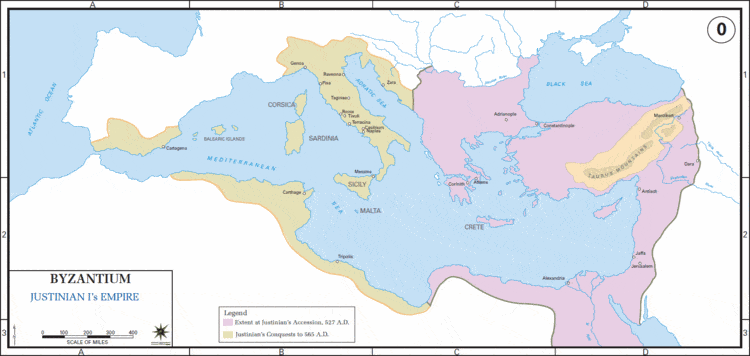
The Byzantine Empire was the continuation of the Roman Empire in the Greek -speaking, eastern part of the Mediterranean.Christian in nature, it was perennially at war with the Muslims, Flourishing during the reign of the Macedonian emperors, its demise was the consequence of attacks by Seljuk Turks, Crusaders, and Ottoman Turks.
Byzantium was the name of a small, but important town at the Bosphorus, the strait which connects the Sea of Marmara and the Aegean to the Black Sea, and separates the continents of Europe and Asia. In Greek times the town was at the frontier between the Greek and the Persian world. In the fourth century BCE, Alexander the Great made both worlds part of his Hellenistic universe, and later Byzantium became a town of growing importance within the Roman Empire.
By the third century CE, the Romans had many thousands of miles of border to defend. Growing pressure caused a crisis, especially in the Danube/Balkan area, where the Goths violated the borders. In the East, the Sasanian Persians transgressed the frontiers along the Euphrates and Tigris. The emperor Constantine the Great (reign 306-337 CE) was one of the first to realize the impossibility of managing the empire's problems from distant Rome.
CONSTANTINOPLE
So, in 330 CE Constantine decided to make Byzantium, which he had refounded a couple of years before and named after himself, his new residence. Constantinople lay halfway between the Balkan and the Euphrates, and not too far from the immense wealth and manpower of Asia Minor, the vital part of the empire.
"Byzantium" was to become the name for the East-Roman Empire. After the death of Constantine, in an attempt to overcome the growing military and administrative problem, the Roman Empire was divided into an eastern and a western part. The western part is considered as definitely finished by the year 476 CE, when its last ruler was dethroned and a military leader, Odoacer, took power.
CHRISTIANITY
IN THE COURSE OF THE FOURTH CENTURY, THE ROMAN WORLD BECAME INCREASINGLY CHRISTIAN, & THE BYZANTINE EMPIRE WAS CERTAINLY A CHRISTIAN STATE.
In the course of the fourth century, the Roman world became increasingly Christian, and the Byzantine Empire was certainly a Christian state. It was the first empire in the world to be founded not only on worldly power, but also on the authority of the Church. Paganism, however, stayed an important source of inspiration for many people during the first centuries of the Byzantine Empire.
When Christianity became organized, the Church was led by five patriarchs, who resided in Alexandria, Jerusalem, Antioch, Constantinople, and Rome. The Council of Chalcedon (451 CE) decided that the patriarch of Constantinople was to be the second in the ecclesiastical hierarchy. Only the pope in Rome was his superior. After the Great Schism of 1054 CE the eastern (Orthodox) church separated form the western (Roman Catholic) church. The centre of influence of the orthodox churches later shifted to Moscow.
CULTURAL LIFE
Since the age of the great historian Edward Gibbon, the Byzantine Empire has a reputation of stagnation, great luxury and corruption. Most surely the emperors in Constantinople held an eastern court. That means court life was ruled by a very formal hierarchy. There were all kinds of political intrigues between factions. However, the image of a luxury-addicted, conspiring, decadent court with treacherous empresses and an inert state system is historically inaccurate. On the contrary: for its age, the Byzantine Empire was quite modern. Its tax system and administration were so efficient that the empire survived more than a thousand years.
The culture of Byzantium was rich and affluent, while science and technology also flourished. Very important for us, nowadays, was the Byzantine tradition of rhetoric and public debate. Philosophical and theological discources were important in public life, even emperors taking part in them. The debates kept knowledge and admiration for the Greek philosophical and scientific heritage alive. Byzantine intellectuals quoted their classical predecessors with great respect, even though they had not been Christians. And although it was the Byzantine emperor Justinian who closed Plato 's famous Academy of Athens in 529 CE, the Byzantines are also responsible for much of the passing on of the Greek legacy to the Muslims, who later helped Europe to explore this knowledge again and so stood at the beginning of European Renaissance.
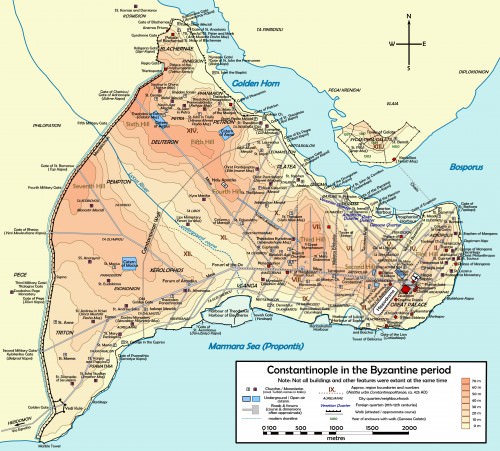
Map of Byzantine Constantinople
JUSTINIAN
Byzantine history goes from the founding of Constantinople as an imperial residence on 11 May 330 CE until Tuesday 29 May 1453 CE, when the Ottoman sultan Memhet II conquered the city. Most times the history of the Empire is divided into three periods.
The first of these, from 330 till 867 CE, saw the creation and survival of a powerful empire. During the reign of Justinian (527-565 CE), a last attempt was made to reunite the whole Roman Empire under one ruler, the one in Constantinople. This plan largely succeeded: the wealthy provinces in Italy and Africa were reconquered, Libya was rejuvenated, and money bought sufficient diplomatic influence in the realms of the Frankish rulers in Gaul and the Visigothic dynasty in Spain. The refound unity was celebrated with the construction of the church of Holy Wisdom, Hagia Sophia, in Constantinople. The price for the reunion, however, was high. Justinian had to pay off the Sasanian Persians, and had to deal with firm resistance, for instance in Italy.
Under Justinian, the lawyer Tribonian (500-547 CE) created the famous Corpus Iuris. The Code of Justinian, a compilation of all the imperial laws, was published in 529 CE; soon the Institutions (a handbook) and the Digests (fifty books of jurisprudence), were added. The project was completed with some additional laws, the Novellae. The achievement becomes even more impressive when we realize that Tribonian was temporarily relieved of his function during the Nika riots of 532 CE, which in the end weakened the position of patricians and senators in the government, and strengthened the position of the emperor and his wife.
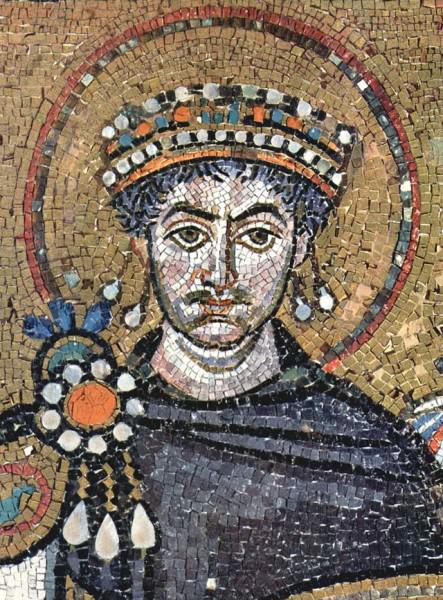
Justinian I
After Justinian, the Byzantine and Sasanian empires suffered heavy losses in a terrible war. The troops of the Persian king Khusrau II captured Antioch and Damascus, stole the True Cross from Jerusalem, occupied Alexandria, and even reached the Bosphorus. In the end, the Byzantine armies were victorious under the emperor Heraclius (reign 610-642 CE).
However, the empire was weakened and soon lost Syria, Palestine, Egypt, Cyrenaica, and Africa to the Islamic Arabs. For a moment, Syracuse on Sicily served as imperial residence. At the same time, parts of Italy were conquered by the Lombards, while Bulgars settled south of the Danube. The ultimate humiliation took place in 800 CE, when the leader of the Frankish barbarians in the West, Charlemagne, preposterously claimed that he, and not the ruler in Constantinople, was the Christian emperor.
MACEDONIAN DYNASTY
The second period in Byzantine history consists of its apogee. It fell during the Macedonian dynasty (867-1057 CE). After an age of contraction, the empire expanded again and in the end, almost every Christian city in the East was within the empire's borders. On the other hand, wealthy Egypt and large parts of Syria were forever lost, and Jerusalem was not reconquered.
In 1014 CE the mighty Bulgarian empire, which had once been a very serious threat to the Byzantine state, was finally overcome after a bloody war, and became part of the Byzantine Empire. The victorious emperor, Basil II, was surnamed Boulgaroktonos, "Slayer of Bulgars". The northern border now was finally secured and the empire flourished.
Throughout this whole period the Byzantine currency, the nomisma, was the leading currency in the Mediterranean world. It was a stable currency ever since the founding of Constantinople. Its importance shows how important Byzantium was in economics and finance.
Constantinople was the city where people of every religion and nationality lived next to one another, all in their own quarters and with their own social structures. Taxes for foreign traders were just the same as for the inhabitants. This was unique in the world of the middle ages.
CRISIS
Despite these favorable conditions, Italian cities like Venice and Amalfi, gradually gained influence and became serious competitors. Trade in the Byzantine world was no longer the monopoly of the Byzantines themselves. Fuel was added to these beginning trade conflicts when the pope and patriarch of Constantinople went separate ways in 1054 CE (the Great Schism).
Decay became inevitable after the Battle of Manzikert in 1071 CE. Here, the Byzantine army under the emperor Romanus IV Diogenes, although reinforced by Frankish mercenaries, was beaten by an army of the Seljuk Turks, commanded by Alp Arslan ("the Lion"). Romanus was probably betrayed by one of his own generals, Joseph Tarchaniotes, and by his nephew Andronicus Ducas.
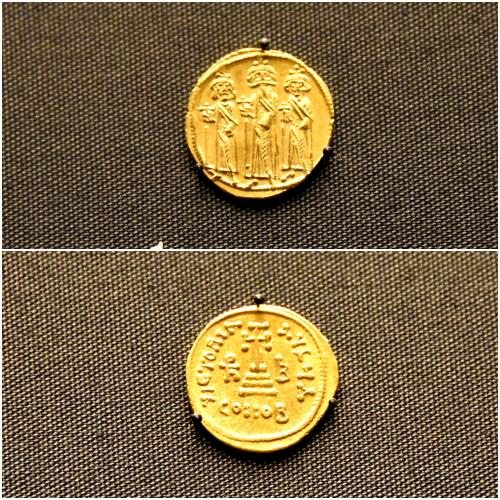
Byzantine coins of Heraclius
After the battle, the Byzantine Empire lost Antioch, Aleppo, and Manzikert, and within years, the whole of Asia Minor was overrun by Turks. From now on, the empire was to suffer from manpower shortage almost permanently. In this crisis, a new dynasty, the Comnenes, came to power. To obtain new Frankish mercenaries, emperor Alexius sent a request for help to pope Urban II, who responded by summoning the western world for the Crusades. The western warriors swore loyalty to the emperor, reconquered parts of Anatolia, but kept Antioch, Edessa, and the Holy Land for themselves.
DECLINE & FALL
For the Byzantines, it was increasingly difficult to contain the westerners. They were not only fanatic warriors, but also shrewd traders. In the twelfth century, the Byzantines created a system of diplomacy in which deals were concluded with towns like Venice that secured trade by offering favorable positions to merchants of friendly cities.
Soon, the Italians were everywhere, and they were not always willing to accept that the Byzantines had a different faith. In the age of the Crusades, the Greek Orthodox Church could become a target of violence too. So it could happen that Crusaders plundered the Constantinople in 1204 CE. Much of the loot can still be seen in the church of San Marco in Venice.
For more than half a century, the empire was ruled by monarchs from the West, but they never succeeded in gaining full control. Local rulers continued the Byzantine traditions, like the grandiloquently named "emperors" of the Anatolian mini-states surrounding Trapezus, where the Comnenes continued to rule, and Nicaea, which was ruled by the Palaiologan dynasty.
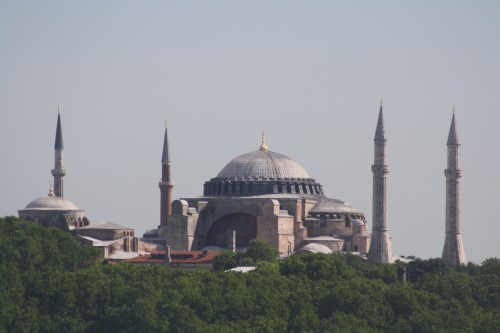
Hagia Sophia
The Seljuk Turks, who are also known as the Sultanate of Rum, benefited greatly of the division of the Byzantine Empire, and initially strengthened their positions. Their defeat, in 1243 CE, in a war against the Mongols, prevented them from adding Nicaea and Trapezus as well. Consequently, the two Byzantine mini-states managed to survive.
The Palaiologans even managed to capture Constantinople in 1261 CE, but the Byzantine Empire was now in decline. It kept losing territory, until finally the Ottoman Empire (which had replaced the Sultanate of Rum) under Mehmet II conquered Constantinople in 1453 CE and took over government. Trapezus surrendered eight years later.
ARTISTIC LEGACY
After the Ottoman take-over, many Byzantine artists and scholars fled to the West, taking with them precious manuscripts.They were not the first ones. Already in the fourteenth century, Byzantine artisans, abandoning the declining cultural life of Constantinople, had found ready employ in Italy. Their work was greatly appreciated and western artists were ready to copy their art. One of the most striking examples of Byzantine influence is to be seen in the work of the painter Giotto, one of the important Italian artists of the early Renaissance.
Etruscan Trade › Origins
Ancient Civilizations
The Etruscan civilization flourished in central Italy between the 8th and 3rd century BCE, and their prosperity was largely based on their exploitation of local mineral resources, both through manufactured goods and trade. The Etruscans exchanged goods not only with their fellow cities in Etruria but also with contemporary Mediterranean civilizations such as the Greeks, Phoenicians, and Near East cultures. Especially noted for their production and export of iron, the Etruscans received in exchange, amongst other things, ivory from Egypt, amber from the Baltic, and pottery from Greece and Ionia. With these trade relations came cultural influences as seen in both Etruscan daily life and art.
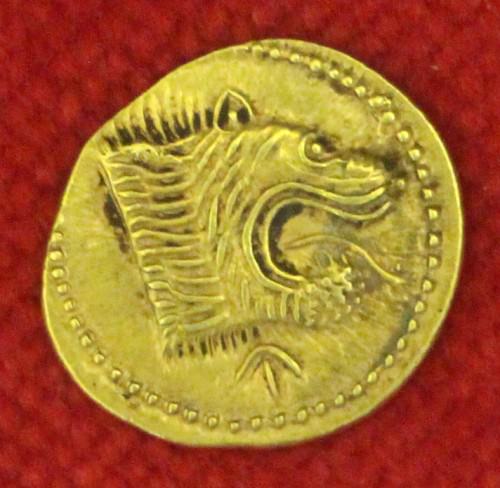
Etruscan Gold Coin
A NETWORK OF INDEPENDENT CITIES
It is perhaps important to note here that when speaking of Etruscan trade we are describing the trade arrangements of individual towns. The Etruscans did not form a cohesive political and economic state, as the historian N. Spivey explains,
It is clear that there was no administered trade at this stage; many small political units were competing on relatively equal terms in an exchange network. Access to this exchange network was restricted to a 'chiefly' elite but was not heavily centralised. (Spivey & Stoddart, 83)
Having said that, it is true that the Etruscan coastal towns generally acted as emporia, especially from the 7th century BCE onwards. From sites such as Cerveteri, Tarquinia, and Populonia goods would then have been traded on into the interior of Etruria. One can imagine that goods from inland sources would have travelled in the opposite direction.
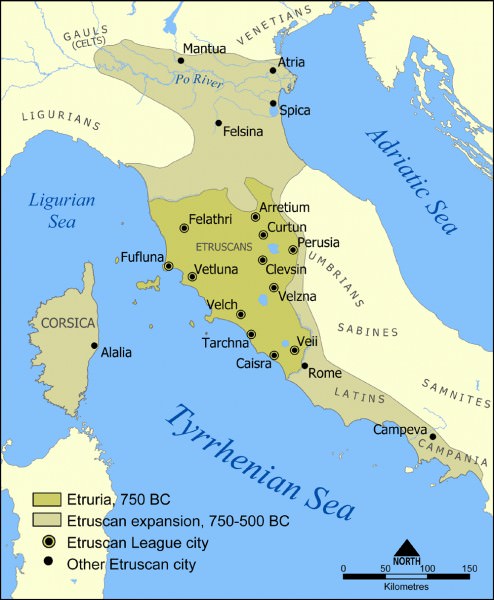
Etruscan Civilization
Goods would have been bartered and paid for in kind, although from the 6th century BCE there is evidence that bronze ingots stamped with a branch without leaves were used to pay for bulk orders. From the 5th century BCE, several Etruscan towns minted their own gold or silver coinage, although this was, as elsewhere in the Mediterranean, probably driven by a necessity to pay soldiers rather than for trade.
VILLANOVAN TRADE
Early Etruscan culture, known as the Iron Age Villanovan culture, developed between 1000 and 750 BCE in western central Italy. The initial prosperity of these peoples was based on rich mineral deposits in the area which included lead, tin, copper, silver, and most of all, iron. Agriculture developed with metal implements improving productivity, which brought a stability and the possibility of a small-scale manufacturing industry of pottery and metal goods. Thus, an exchange of goods took place between Etruscan towns, especially those on the coast and near rivers where access inland was made easier. In addition, bronze works discovered at Etruscan sites indicate contact with Sardinia, central Europe, the Balkans and even the Cyclades. These links brought about a more advanced metallurgy, but the flowering of Etruscan trade was only just beginning.
EVENTUALLY, THE MINERAL RESOURCES & THE INCREASED WEALTH OF THE ETRUSCANS BEGAN TO ATTRACT FOREIGNERS TO THE AREA.
EXPANDING HORIZONS
Eventually, the mineral resources and the increased wealth of the Etruscans began to attract foreigners to the area. In the 8th century BCE Euboeans, via their base at Pithecusae (Ischia), introduced themselves to the Etruscans. Also in the 8th century BCE, or even earlier, trade links were established with contemporary cultures in Egypt, Phoenicia, Ionia, and the Near East, all eager to find new metal sources. This is evidenced by finds of, for example, ostrich eggs (decorated in Etruria), ivory goods, glass paste jewellery, and metal objects distinctive to their place of production such as small bronze boats from Sardinia and scarabs from Egypt. Fine Greek pottery seems to have been especially esteemed by the Etruscans, and this came from workshops in Sparta, Corinth, Eastern Greece, and above all, Attica. There is also evidence that pottery wares were even made to suit Etruscan tastes. Foreign imports did not put a stop to local production as wares by the Micali painter of Vulciillustrate. His vessels have been found at sites across Etruria and show that local trade prospered alongside international exchange. Other foreign imports would have included gold, ivory, fine wooden furniture, glass bottles for perfumes and creams, oil lamps, and slaves.

Attic Black-figure Plate, Vulci
Such was the Etruscan maritime presence in this period that they gained a reputation for piracy which lasted throughout antiquity. The manufacturing industry, already booming thanks to a ready supply of raw materials, further benefitted from artists and craftsmen from Greece and the Levant coming in person to set up shop in Etruria, such was the demand for precious metal goods and fine pottery. Many of these foreign artists and traders established themselves in specialised coastal trading areas – emporia. Here they could live as they wished, protected by their sanctuaries and able to worship their religion, in effect, a home away from home. The most important of these emporia were Pyrgi (a port of Cerveteri), Regae (Vulci), and Gravisca (Tarquinia). Thus, the Etruscans were guaranteed a continuous supply of the luxury goods which they required for everyday use or as votive offerings at sanctuaries or for goods to be left to accompany the dead in the large painted tombs of the Etruscan elite over the centuries.
SUCCESSFUL EXPORTS
By the 6th century BCE, Etruscan grain, pine nuts, olive oil, and wine were being exported in large quantities. Chiusi produced fine stone sculpture and bronze cauldrons. Pisa was noted for its marble and wood suitable for shipbuilding, Cerveteri gained fame for its goldwork and distinctive two-handled pottery water vessels, Populonia was one of the Mediterranean's main producers of pig iron (smelting ore from Elba), Tarquinia had its linen production, Veii produced pottery and bronze horse bits, and Vulci had countless workshops where just about everything was produced from painted ostrich eggs to inlaid ivory plaques.
An increase in competition from Greek and Carthaginian traders, though, drove the Etruscans to look for new markets inland, and these they found in the Celts on the other side of the Alps. Wine exports are attested by the many finds there of the large bronze jugs made at Vulci. Amphorae made at Vulci carrying the local wine have been found right along the Etrurian coast and in Provence, Alicante, and on the islands of Sicily and Naxos.
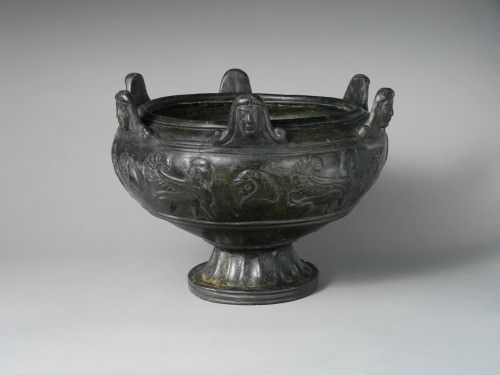
Bucchero Krater
Another successful Etruscan export was bucchero, their own distinctive pottery with a near-black glossy finish. Examples of bucchero have been found along the coastal areas of southern France and northwestern Spain, at Athens, Sparta, and Corinth, on Corfu and Cyprus, at Carthage, in Romania, Syria, Libya, and Egypt. That other Etruscan manufactured goods (horse bits, helmets, and shields) were appreciated by foreign cultures is seen in their use as votive offerings at such important 'international' religious sites as Olympia, Delphi, and Dodona. In addition, Italian-made fibulae (buckles) have been excavated on Aegina, Rhodes, and Samos.
COMPETITION FOR TRADE
Naturally, the Etruscans did not have everything their own way, and other trading cultures frequently sought to muscle in on their lucrative trade routes. Etruscan cities signed a treaty with Carthage to agree on exclusive areas of operation in 509 BCE, but the pair had to defend their interests against a Greek naval fleet. This they did with success at the Battle of Alalia (aka Battle of the Sardinian Sea) in 540 BCE. In the 5th century BCE, Syracuse was the dominant Mediterranean trading power, and the Sicilian city combined with Cumae to inflict a naval defeat on the Etruscans at the battle at Cumae in 474 BCE. Worse was to come when the Syracusan tyrant Dionysius I decided to attack the Etruscan coast in 384 BCE and destroy many of the Etruscan ports. By the late 4th century BCE Rome was beginning to flex its muscles in the region too, and these factors contributed significantly to the loss of trade and the consequent decline of many Etruscan cities seen from the 4th century BCE onwards.
LICENSE
Article based on information obtained from these sources:with permission from the Website Ancient History Encyclopedia
Content is available under License Creative Commons: Attribution-NonCommercial-ShareAlike 3.0 Unported. CC-BY-NC-SA License